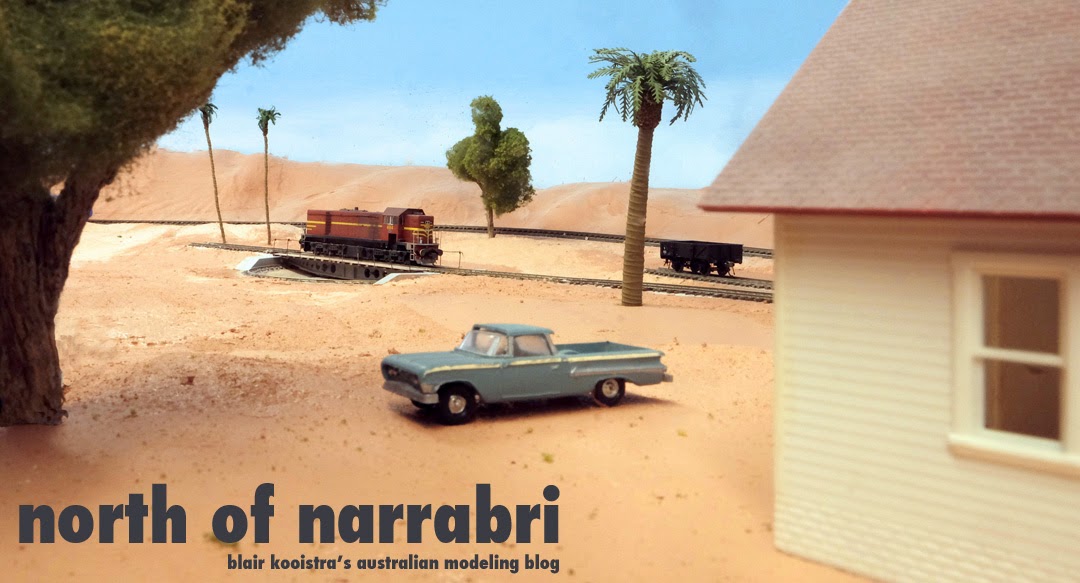
Safe Hands, signalman Vic Smee, Kankool, May 1965. Photo copyright Robert and Bruce Wheatley
My wife Mary treated me great for Christmas, for she braved the rigors and fears of overseas credit transactions and two-week shipping times to give me the Wheatley brother's Railway Portraits Volume Two.
What a wonderful book, just as their first one was. Besides the quality of the images, their photography from the final days of steam railroading on the NSWGR appeals to me in so many ways--their ability to capture a moment, composition, and story-telling qualities, sure, but the humanity of the endeavour of operating the railway comes through in each photograph. I feel a connection to the people in the photographs, but also to the photographers, for how they came to make these photographs is very similar to my own early days trackside. While Robert and Bruce made themselves a fixture in the loco depots and platforms of the railway in the late 60s and early 70s, I too took up a camera in my mid-teens and spent a couple of intensive years photographing in black and white a railroading way of life that was doomed: the last years of the legendary Milwaukee Road in the Pacific Northwest of the states.
We certainly shared similar experience: late night photo sessions trackside in freight yards; roaming the locomotive shops as heavy repairs were being done; asking for cab rides; nagging station staff for train movement information; and, when the photography was all done, coming home and developing those black and white images in a makeshift darkroom in Mom's laundryroom.
Though I'm not a steam guy, per se (though the texture and detail in adding steam locomotives are certainly tempting to model!), much of the infrastructure and process of operating the NSWGR in 1965 was the same as it was in 1978-80, my modeling era. Thus, the photographs are a deep well of information to dissect and apply to my modeling.
Not only do I have the disadvantage of modeling an era now 30 years in the past, I model a location I really have no intimate knowledge of--so recollections of those who were there and books and photographs are mostly all I have to go on. That said, developing a library to assist my modeling is essential.
What are my essential titles in my Australian railway library? In no particular order:
- Railway Portraits, Vol. 1 & 2
- Day of the Goods Train, Ron Preston, Eveleigh Press: the nuts and bolts of operating goods trains, from infrastructure to goods sheds, wagons and air brakes to telegram messages.
- From Grease to Gold Braid, Ken Ames, Iron Horse Press: for this Yank, a great autobiography of how "coming up through the ranks" worked in NSW. The lifetime career of a station master, his training, assignments and responsibilities. Drags a bit at times, but lots of nuggets of information I can apply to the model railway.
- 48:Backbone of the Railway, Ron Preton, Eveleigh Press. The essential book on the essential NSWGR branchline locomotive. Really what inspired me to model Oz railways in the first place.
- Units in Focus, Mead, Cotterall, Renton, Roundhouse Press. I've borrowed Lance Lassen's copy of this long out-of-print 1980 title so long he probably doesn't remember I have it. Precisely the era I model, and a fascinating mix of locos and freight loading back when trains were short and guard vans still rode along for the ride. Many great views of wheat trains out of the North-West. A companion title to Cotterall's earlier end-of-steam book.
- Country Railway Stations: New South Wales series, edited by John Sargent, Train Hobby Publication. Chances are there's a station depicted in this six-volume series that you're currently modeling. Invaluable color resource depicting structures, paint colors, track arrangements and trains.
- Branchline Modeler/Australian Journal of Railway Modeling,Vol. 1-10: Thank God these are still available. In depth coverage of modeling projects and topics, the likes of which you won't find much anymore in the current leading Australian railway modeling magazine. And not one article on recycling old film canisters or paint can lids! Hopefully, this magazine will come back in the near future.
- Modeling the Railways of New South Wales, Convention Notes, 1986-2007. A full CD-R chock full of varied notes on convention topics; sort of a more organic version of AJRM on PDF.
- Freight Wagons in New South Wales, 1982 John Beckhaus, AHRS, 1982. I've got to hand it to the "Mexicans," as they have probably a half-dozen titles on rolling stock: passenger equipment, two-axle and bogey freight wagons, etc. covering the Victorian Rail fleet. This thin thirty-year-old glimpse of the NSW PTC freight roster will have to do, I suppose. Not particularly well-illustrated given the constraints of format, but a snapshot of the fleet right at the tail end of the transition from two-axle equipment to modern bogey freight cars, just as the four-letter Australian-wide code system took over. I've scanned it to PDF's and store it on the hard-drive for easier access.
- A Bulldog Odyssey, Bamberry. While these gorgeous EMD's were never found in Narrabri, and the book covers NSW only as part of a continental view, the color photography within its pages is stunning and inspiring.


















































